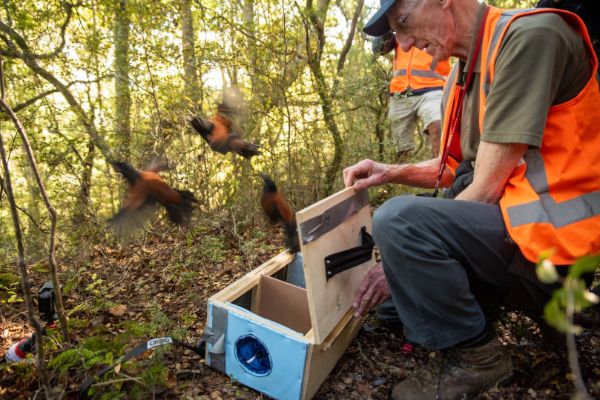Sound Of The Saddleback Comes Home To Nelson

In a homecoming a hundred years in the making, the release of South Island tīeke or saddleback (Philesturnus carunculatus) at the Brook Waimārama Sanctuary today (19 April) will mean that mainlanders will once again have a chance to hear the distinctive “cheeet ta-chet ta-chet ta-chet” of this rare wattlebird.
Up to 40 tīeke will be released into the pest-free Sanctuary during the week, with the first group being delivered by helicopter from Motuara Island today.
Sanctuary Chief Executive Ru Collin says that the release of the tīeke is a milestone for native species recovery in Nelson.
“Tīeke were once part of our natural forest ecosystem. The Sanctuary is now ready to provide a safe pest-free fenced haven for the first South Island mainland population. We will do all we can to ensure they thrive in our care and hope that in the long-term we will see a stable population here over-flowing into the Mount Richmond forest beyond the fence.”
The South Island tīeke was once widespread throughout the South Island and Stewart Island but their slow breeding cycle and tendency to nest, forage and roost on or near ground level meant they stood little chance against introduced pests like rats and stoats. They were extinct on the South Island and Stewart Island by about 1900. The population that survives today is descended from 36 birds saved from rat infestation on the South Cape islands in the 1960s and translocated to predator-free islands.
The tīeke is now listed as At Risk/Recovering by the Department of Conservation, with a strong population on Motuara Island providing the birds that will be released in the Brook Waimārama Sanctuary.
Chris Hawkes, the chair of the Brook Waimārama Sanctuary Board of Trustees, reflected on the event: “The significance of this occasion is on many dimensions but primarily it is the accumulation of untold hours of thought, planning, heartache and triumph, with the associated highs and lows that have brought the intention of the Sanctuary to this reintroduction point. It is the result of many years work and marks the start of the ultimate purpose and multiple objectives of the Sanctuary for preservation of our native species, protection of our heritage for future generations and well-being for the people of the region”.
The 700ha fenced Brook Waimārama Sanctuary offers plenty of space for re-introduced species to establish in a pest-free, monitored environment. The connection with the Richmond Forest Park backcountry means that once established, the birds will be able to spread their wings beyond the sanctuary. Its accessibility to the public offers a great opportunity to share the story and encourage people to engage with nature.
Once released, the birds will be monitored by staff and volunteers, and visitors will be asked to record any sightings with Sanctuary staff. Keeping the Sanctuary pest-free will be critical to the survival of the tīeke, and the Brook Waimārama Sanctuary Trust is seeking extra volunteers to help with pest surveillance and monitoring.
Mayor Rachel Reese, who attended the release ceremony, said that the benefits are starting to flow from the years of hard work to create the pest-free sanctuary. “The vision of the trust – bringing nature back to Nelson – is a little closer with the release of these beautiful birds. I’m hoping we will soon be able to enjoy the sight and sound of the tīeke in our forests.”


 Gordon Campbell: On Why We Can’t Survive Two More Years Of This
Gordon Campbell: On Why We Can’t Survive Two More Years Of This ACT New Zealand: Too Many Kiwis Denied The Chance To Gather With Loved Ones At The End Of Life
ACT New Zealand: Too Many Kiwis Denied The Chance To Gather With Loved Ones At The End Of Life Lady Tureiti Moxon: Honouring Kahurangi Tariana Turia - A Legacy of Courage, Leadership, and Tino Rangatiratanga
Lady Tureiti Moxon: Honouring Kahurangi Tariana Turia - A Legacy of Courage, Leadership, and Tino Rangatiratanga Biosecurity NZ: Biosecurity NZ Investigating And Boosting Trapping After Auckland Fruit Fly Find
Biosecurity NZ: Biosecurity NZ Investigating And Boosting Trapping After Auckland Fruit Fly Find NZ Customs Service: New Year Begins With Customs Arrests For Three Alleged Drug Couriers
NZ Customs Service: New Year Begins With Customs Arrests For Three Alleged Drug Couriers Helen Leahy: Honourable Dr Dame Tariana Turia
Helen Leahy: Honourable Dr Dame Tariana Turia Animal Justice Party: Major Brands Linked To Alleged Widespread Animal Cruelty In New Zealand Wool Industry
Animal Justice Party: Major Brands Linked To Alleged Widespread Animal Cruelty In New Zealand Wool Industry


